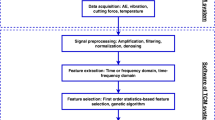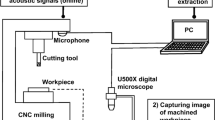Abstract
The aim of this work was to identify the occurrence of machine tool wear in carbide inserts applied in a machine turning center with two steel materials. Through the data collected with an open-source communication protocol during machining, eighty trials of twenty runs each were performed using central composite design experiments, resulting in a data set of eighty lines for each tested material. The data set consisted of forty lines with the tool wear condition and forty lines without. Machining parameters were set to be in the range of the usual industrial values. The cutting parameters in the machining process were cutting speed, feed rate, cutting depth, and cutting fluid applied in the abundance condition and without cutting fluid (dry machining). The collected data were the spindle motor load, X-axis motor load, and Z-axis motor load in terms of the percentage used. AISI P20 and AISI 1045 steels workpieces were tested with both new and worn inserts, and a flank tool wear of 0.3 mm was artificially induced by machining with the same material before the data collecting experiment. Two approaches were used in order to analyze the data and create the machine learning process (MLP), in a prior analysis. The collected data set was tested without any previous treatment, with an optimal linear associative memory (OLAM) neural network, and the results showed 65% correct answers in predicting tool wear, considering 3/4 of the data set for training and 1/4 for validating. For the second approach, statistical data mining methods (DMM) and data-driven methods (DDM), known as a self-organizing deep learning method, were employed in order to increase the success ratio of the model. Both DMM and DDM applied along with the MLP OLAM neural network showed an increase in hitting the right answers to 93.8%. This model can be useful in machine monitoring using Industry 4.0 concepts, where one of the key challenges in machining components is finding the appropriate moment for a tool change.









Similar content being viewed by others
References
Wu D, Jennings C, Terpenny J, Gao RX, Kumara S (2017) A comparative study on machine learning algorithms for smart manufacturing: tool wear prediction using random forests. J Manuf Sci Eng 139(7):9
du Preez A, Oosthuizen GA (2019) Machine learning in cutting processes as enabler for smart sustainable manufacturing. Procedia Manuf 33:810–817. https://doi.org/10.1016/j.promfg.2019.04.102
Azmi AI (2015) Monitoring of tool wear using measured machining forces and neuro-fuzzy modelling approaches during machining of GFRP composites. Adv Eng Softw 82:53–64. https://doi.org/10.1016/j.advengsoft.2014.12.010
Yang Y, Chen N, Guo Y, Huang Z, Li L, Jiang Y, He N (2019) Research on the milling tool wear and life prediction by establishing an integrated predictive model. Measurement. https://doi.org/10.1016/j.measurement.2019.05.009
Kilundu B, Dehombreux P, Chiementin X (2011) Tool wear monitoring by machine learning techniques and singular spectrum analysis. Mech Syst Signal Process 25(1):400–415. https://doi.org/10.1016/j.ymssp.2010.07.014
Garcıa-Ordas MT, Alegre E, Gonzalez-Castro V, Alaiz-Rodrıguez R (2017) A computer vision approach to analyze and classify tool wear level in milling processes using shape descriptors and machine learning techniques. Int J Adv Manuf Technol 90:1947–1961
García-Ordás MT, Alegre-Gutiérrez E, Alaiz-Rodríguez R, González-Castro V (2018) Tool wear monitoring using an online, automatic and low cost system based on local texture. Mech Syst Signal Process 112:98–112
Li X, Dong S, Venuvinod PK (2000) Hybrid learning for tool wear monitoring. Int J Adv Manuf Technol 16:303–307
Aghazadeh F, Tahan A, Thomas M (2018) Tool condition monitoring using spectral subtraction and convolutional neural networks in milling process. Int J Adv Manuf Technol 98:3217–3227
Gouarir A, Martínez-Arellano G, Terrazas G, Benardos P, Ratchev S (2018) In-process tool wear prediction system based on machine learning techniques and force analysis. Procedia CIRP 77:501–504. https://doi.org/10.1016/j.procir.2018.08.253
Kong D, Chen Y, Li N, Duan C, Lu L, Chen D (2019) Relevance vector machine for tool wear prediction. Mech Syst Signal Process 127:573–594. https://doi.org/10.1016/j.ymssp.2019.03.023
Wang P, Liu Z, Gao RX, Guo Y (2019) Heterogeneous data-driven hybrid machine learning for tool condition prognosis. CIRP Ann. https://doi.org/10.1016/j.cirp.2019.03.007
Li Y, Liu C, Hua J, Gao J, Macropoulos P (2019) A novel method for accurately monitoring and predicting tool wear under varying cutting conditions based on meta-learning. CIRP Ann. https://doi.org/10.1016/j.cirp.2019.03.010
Shaban Y, Yacout S, Balazinski M, Jemielniak K (2017) Cutting tool wear detection using multiclass logical analysis of data. Mach Sci Technol 21(4):524–541
Jose B, Nikita K, Patil T, Hemakumar S, Kuppan P (2018) Online monitoring of tool wear and surface roughness by using acoustic and force sensors. Materials Today: Proceedings
MTConnect R Standard Part 1.0 (2019) Overview and Fundamentals Version 1.5.0, MTConnect Institute
MTConnect R Standard part 4.1 (2019) cutting tools version 1.5.0, MTConnect Institute
Tedeschi S, Mehnen J, Tapoglou N, Roy R (2017) Secure IoT devices for the maintenance of machine tools. Procedia CIRP 59 (TESConf 2016):150–155. https://doi.org/10.1016/j.procir.2016.10.002
Liu C, Xu X (2017) Cyber-physical machine tool - the era of machine tool 4.0. Procedia CIRP 63:70–75. https://doi.org/10.1016/j.procir.2017.03.078
Chen J, Hu P, Zhou H, Yang J, Xie J, Jiang Y, Zhang C (2019) Toward intelligent machine tool. Engineering 5(4):679–690. https://doi.org/10.1016/j.eng.2019.07.018
Zhong RY, Wang L, Xu X (2017) An IoT-enabled real-time machine status monitoring approach for cloud manufacturing. Procedia CIRP 63:709–714. https://doi.org/10.1016/j.procir.2017.03.349
Liu W, Tang R, Peng T (2018) An IoT-enabled approach for energy monitoring and analysis of die casting machines. Procedia CIRP 69(May):656–661. https://doi.org/10.1016/j.procir.2017.11.109
Mourtzis D, Milas N, Athinaios N (2018) Towards machine shop 4.0: a general machine model for CNC machine-tools through OPC-UA. Procedia CIRP 78:301–306. https://doi.org/10.1016/j.procir.2018.09.045
Hinchy EP, O’Dowd NP, McCarthy CT (2019) Using open-source microcontrollers to enable digital twin communication for smart manufacturing. Procedia Manuf 38:1213–1219. https://doi.org/10.1016/j.promfg.2020.01.212
Liu C, Xu X, Peng Q, Zhou Z (2018) MTConnect-based cyber-physical machine tool: a case study. Procedia CIRP 72:492–497. https://doi.org/10.1016/j.procir.2018.03.059
Hu L, Nguyen NT, Tao W, Leu MC, Liu XF, Shahriar MR, Al Sunny SMN (2018) Modeling of cloud-based digital twins for smart manufacturing with MT connect. Procedia Manuf 26:1193–1203. https://doi.org/10.1016/j.promfg.2018.07.155
Liu C, Vengayil H, Lu Y, Xu X (2019) A cyber-physical machine tools platform using OPC UA and MTConnect. J Manuf Syst 51(April):61–74. https://doi.org/10.1016/j.jmsy.2019.04.006
Lynn R, Wescoat E, Han D, Kurfess T (2018) Embedded fog computing for high-frequency MTConnect data analytics. Manuf Lett 15:135–138. https://doi.org/10.1016/j.mfglet.2017.11.002
Mazak (2019) https://www.mazak.com.br/mtconnect/,
Li Z, Liu R, Wu D (2019) Data-driven smart manufacturing: tool wear monitoring with audio signals and machine learning. J Manuf Process 48(July):66–76. https://doi.org/10.1016/j.jmapro.2019.10.020
Cica D, Sredanovic B, Tesic S, Kramar D (2020) Applied computing and informatics predictive modeling of turning operations under different cooling / lubricating conditions for sustainable manufacturing with machine learning techniques. Applied Comput Inform. https://doi.org/10.1016/j.aci.2020.02.001
Peng B, Bergs T, Schraknepper D, Klocke F, Döbbeler B (2019) A hybrid approach using machine learning to predict the cutting forces under consideration of the tool wear. Procedia CIRP 82:302–307. https://doi.org/10.1016/j.procir.2019.04.031
Karandikar J (2019) Machine learning classification for tool life modeling using production shop-floor tool wear data. Procedia Manuf 34:446–454. https://doi.org/10.1016/j.promfg.2019.06.192
Kohonen T (1972) Correlation matrix memories. IEEE Trans Comput C-21(4):353–359
Stavropoulos P, Papacharalampopoulos A, Vasiliadis E, Chryssolouris G (2019) Tool wear predictability estimation in milling based on multi-sensorial data P. Int J Adv Manuf Technol 82:509–521. https://doi.org/10.1007/s00170-015-7317-6
Konstantinos S, Athanasios K (2014) Reliability assessment of cutting tool life based on surrogate approximation methods. Int J Adv Manuf Technol 71(5–8):1197–1208. https://doi.org/10.1007/s00170-013-5560-2
Wiklund H (1998) Bayesian and regression approaches to on-line prediction of residual tool life. Qual Reliab Eng Int 14(5):303–309. https://doi.org/10.1002/(SICI)1099-1638(199809/10)14:5<303::AID-QRE155>3.0.CO;2-F
Karandikar J, McLeay T, Turner S, Schmitz T (2015) Tool wear monitoring using naïve Bayes classifiers. Int J Adv Manuf Technol 77:1613–1626. https://doi.org/10.1007/s00170-014-6560-6
Author information
Authors and Affiliations
Corresponding author
Additional information
Publisher’s note
Springer Nature remains neutral with regard to jurisdictional claims in published maps and institutional affiliations.
Rights and permissions
About this article
Cite this article
de Farias, A., de Almeida, S.L.R., Delijaicov, S. et al. Simple machine learning allied with data-driven methods for monitoring tool wear in machining processes. Int J Adv Manuf Technol 109, 2491–2501 (2020). https://doi.org/10.1007/s00170-020-05785-x
Received:
Accepted:
Published:
Issue Date:
DOI: https://doi.org/10.1007/s00170-020-05785-x




